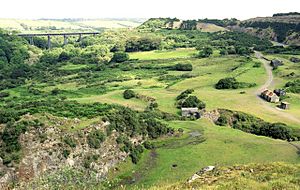Meldon Quarry facts for kids
Meldon Quarry is a special place in Devon, England, where people dig up rocks from the ground. It's a granite quarry, which means it's known for its very hard granite stone. You can find it near the northern edge of Dartmoor, about two miles southwest of a town called Okehampton.
This quarry became really important starting in 1897. Its main job was to provide stone for the London and South Western Railway (LSWR). This stone was used for something called "track ballast," which helps keep railway tracks stable. Later, in 1994, the quarry became a private business.
Contents
What is a Quarry?
A quarry is like a big open-air mine where useful rocks and minerals are dug out from the earth. At Meldon, they dug out granite. Granite is a very strong and tough rock, which makes it perfect for building and for railway tracks.
Stone for Railways
The story of Meldon Quarry began in 1874. A small quarry was opened to provide stone for the local railway lines. This was around the same time the LSWR extended its railway from Okehampton to Lydford, right where the quarry is located.
Why Meldon's Stone Was Special
In 1897, the quarry grew much bigger. It started supplying most of the track ballast needed by the LSWR. Track ballast is the layer of crushed stone that sits under railway tracks. It helps to:
- Keep the tracks in place.
- Drain water away.
- Spread the weight of trains evenly.
Meldon's granite was perfect because it was harder and lasted longer than other stones found closer to the railway's main areas. By 1953, the quarry was producing a huge amount of stone, about 340,000 tons every year! Inside the quarry, they even used small, movable railway lines, called tramways, to move the stone around.
Changes Over Time
Even after the railways became owned by the government (this is called nationalisation), the stone from Meldon was still considered excellent. However, it was quite far away, so transporting the stone became expensive. In the 1980s, it sometimes became cheaper to bring good quality stone all the way from Scotland by ship!
In 1994, as part of a big change, the quarry was sold to a private company called ECC Quarries Ltd. The railway line that led only to the quarry was also sold at this time.
Staff Platform
Because Meldon Quarry was in a remote area, far from towns, there was a special platform for the workers. This allowed them to get to and from work by train. You can learn more about it at Meldon Quarry railway station.
Quarry Locomotives
Moving heavy wagons full of stone around the quarry was a big job. At first, horses did this work! But in 1927, the quarry got its first steam locomotive.
Early Steam Engines
- The first locomotive was a Manning Wardle 0-4-0ST engine. It had worked at Folkestone Harbour before coming to Meldon. It was numbered 313 but became service locomotive 225S at Meldon. It worked there until 1938.
- After that, a SECR class T 0-6-0T engine, number 1607, became the main locomotive. It was renumbered 500S and worked from 1938 to 1948.
- Later, other steam engines took over, including LSWR G6 class 0-6-0T locomotives. One was number 72 (later DS3152), which worked from 1949 to 1960. Another G6, number 30238 (later DS682), worked until 1962.
- The last steam engine to work regularly at the quarry was a USA 0-6-0T engine, number DS234. It worked from 1962 until October 1966.
Diesel Power
After 1966, the quarry stopped using steam engines. Instead, they started using modern diesel shunter locomotives, which are more efficient for moving wagons around.


